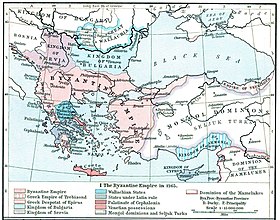Treaty of Nymphaeum (1261)

The restored Byzantine Empire in 1265, shortly after the Treaty of Nymphaeum and the demise of the Latin Empire.
|
|
| Signed | March 13, 1261 |
|---|---|
| Location | Nymphaeum |
| Signatories |
Empire of Nicaea Republic of Genoa |
The Treaty of Nymphaeum was a trade and defense pact signed between the Empire of Nicaea and the Republic of Genoa in Nymphaion in March 1261. This treaty would have a major impact on both the restored Byzantine Empire and the Republic of Genoa that would later dictate their histories for several centuries to come.
Following the sack of Constantinople by the Fourth Crusade in 1204, the Empire of Nicaea was established as one of the successor states to the Byzantine Empire. After a violent and chaotic beginning, Nicaea was able to preserve its hold on the territories along the western coast of Asia Minor against the Latin Empire to the north and the Seljuk Turks to the east. After the Treaty of Nymphaeum of 1214, the Nicaean Empire was able to slowly expand its borders at the expense of the Latins and reclaim a good part (but not all) of the original Byzantine territory, and by the 1230s, the Latin Empire consisted of little more than just Constantinople itself. In all its history, however, the city had never been taken without the control of the surrounding sea access to the city itself. Around the late 1250s and early 1260s, Venice still maintained a sizable patrol of thirty ships in the Bosporus to keep control of the straits and keep the Nicaeans at bay. The Nicaean fleet – fairly large during this time in their history – was able to take back and exert control over several of the Aegean islands, and were a direct threat to Latin-controlled Constantinople, but still no match against the Venetian fleet which the Latins were allied with. This was clearly shown in the joint Nicaean-Bulgarian siege of Constantinople in 1235, when the blockading Nicaean fleet, of allegedly 100 ships, was defeated by a Venetian force one quarter its size. The failed Nicaean Siege of Constantinople in 1260 also pressed the need further for a fleet on any future attack on Constantinople.
...
Wikipedia
